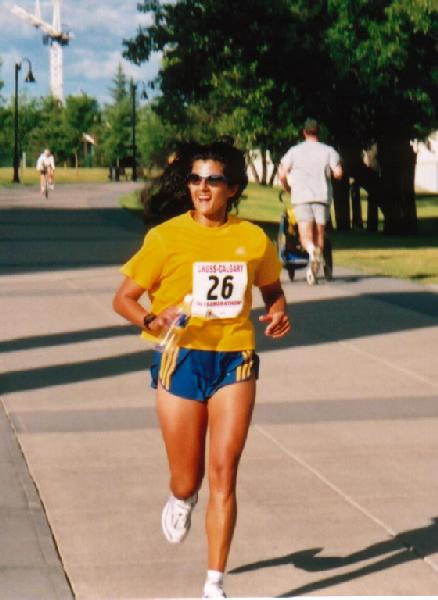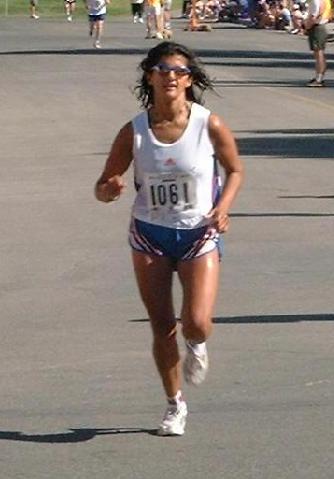|
Women in Motion August 2001
enhancing running performance Vol 2. Issue 12 WOMEN IN MOTION NEWSLETTER - August 2001
This Month Contains: ~Article: Muscular Endurance ~From Around the 'Net 1. Watching your
downhill stride ~Words
of Inspiration ~The
Running Woman Board ~Report on the Calgary Marathon Muscular
Endurance
Muscular endurance is a health-related component of
physical fitness. It is the ability of a skeletal muscle or group of muscles
to continue contracting over a long period. When you have good muscular
endurance you have the ability to resist fatigue while holding a
position, carrying something for a long period of time, or repeating
a movement without getting tired. As you train for muscular endurance,
the muscles adapt as a result of changes in the slow-twitch
fibers. The slow twitch fibres have a high capacity to use oxygen. They
are called red fibres due to the large amount of blood supply found in
them. They are slow to contract but have the ability to continue to
contract over long periods of time.
Lifting heavy weights with low repetitions will develop
strength. Dynamic muscular endurance is the opposite. You must do
higher numbers of repetitions and with lower resistance. Dynamic muscle
endurance is the muscle's ability to contract and relax repeatedly. An
example of an exercise requiring dynamic endurance is the push-up. At
some point, the muscles will become fatigued, and you will no longer be
able to perform them. Examples of everyday activities requiring
dynamic endurance are carrying groceries to your car, raking your
yard, and playing several sets of tennis. Each of these activities
requires some muscular strength, but they also require the muscle to
repeat the movement over a period of time.
A muscle's ability to remain contracted for a long period
of time is called static muscle endurance. It is usually measured by
the length of time you can hold a body position. For example using the
pushup, if we measure the length of time a person can remain in the
flexed arm position, we are measuring static endurance. This means
lowering the body in the pushup position until the arms are in a
ninety-degree angle parallel to the floor and holding this position as
long as possible. Some activities requiring static endurance
include handstands and standing in line for hours for concert
tickets or rides at the midway.
There are a wide variety of effective programs for
developing muscular endurance. One of the most popular methods is circuit
resistance training. This training takes place by moving from one
station to the next, usually set up in a circle. At each station a
different exercise is performed with high repetitions but low to moderate
resistance. Fifteen seconds of rest is provided while changing
stations. Approximately ten exercise stations are used, and the
exerciser repeats the circuit two to three times. Many people are interested in endurance exercises because
they can take inches off of body measurements. Usually some
strengthening and some changes in body contour occur. Also, endurance
exercises speed up metabolism, and your body burns calories at a higher rate
for several hours after the endurance exercise.
Cardiovascular endurance depends upon the efficiency of the
heart
muscle, circulatory system and respiratory system. Muscular
endurance
depends on the efficiency of the skeletal muscles and the
nerves that
control them. You can train for cardiovascular endurance by
running,
but if the leg muscles lack the muscular endurance to
continue for
more than a few minutes, you will not be able to run long enough to
develop cardiovascular endurance.
It is also important to remember that the training program
for
muscular endurance should resemble the activity for which
the
endurance is needed. Performing muscular endurance
exercises with upper body muscles will not help improve the endurance of
the leg
muscles. Probably the best training program is performing
the sport skill repeatedly. From Around the
Net 1. Downhill
running pounds the feet, stresses the 2.
There
is no need to worry about the effects of fast, high-impact
training on your body. A new study has found that as you increase
the force of impact there is not an added strain in the shinbone.
The strain rate stays the same and keeps you from breaking your
leg. Damage is most likely to occur when high impact exercising is
suddenly introduced to a training program. 3.
Everyone can benefit from doing some hill accelerations. Hill training provides a gentle and effective transition between very slow running and the faster speed play needed by veteran marathoners for faster performance. If you're just starting to run, you shouldn't jump into hill play. But those who've been running regularly for six months or more can benefit from the strength increase which only hill training can give. You don't have to have a time goal to benefit from play on the hills
4. Eating the
right food at the right time makes you a better runner. An athlete's body needs to have a carefully
adjusted formula of high-test fuel to perform at its best during
competition. That dietary formula often varies according to individual,
but there are some good rules of thumb for eating before
competition. Finding the right food and timing your meal appropriately can
make a big difference in both performance and comfort during a race. 6. When in doubt,
use less energy and stay lower to the ground, and you'll run smoother and
quicker with better leg turnover. The energy spent in bouncing too high
even by an inch is wasted - burned up in the air. The higher you lift
yourself off the ground, the greater shock you have to absorb when landing
and the longer it'll take for your feet and legs to recover from that run. 7.
Prolonged
running greatly affects the pushing off force production in
the quadriceps muscle. This is due to a breakdown of the
mechanism that contracts the muscles, particularly in the
fast-twitch muscle fibres. To improve muscle strength and
performance in long-distance running focus on eccentric weight
training at the gym. That is, concentrate on lowering
the weight slowly. The Running Woman Message
Board The Running Woman Message board continues
to be active. It continues a steady pickup in volume,
hopefully because of the interest in using running as part of
a renewed lifestyle. Let's hope they connect with the benefits
of running. We continue to offer advice to all posts. Thanks
to all of you who have provided assistance to members old and
new. Good Luck and Continued Running to
all. All
clubs are closed and Women in Motion is in the process of
transferring the email addresses of both the Runners
Club memberships to it's
newsletter list and when this is complete, members will be
given the choice of continuing to receive the monthly
newsletters or of being removed from the email
list. Good Luck and Great Runs
Words of
Inspiration
"There is a bond that links the 4:15 marathoner with the
"god" who
- Rich
Segal, in his introduction to Richard Benyo's Masters of the
Marathon ('sisters'
substituted for original word 'brothers') Report on
The Calgary Stampede Roadeo
Road Race Marathon was held on Sunday, July 8th at 7:00 a.m.
Hot, hot, hot. It was hot. Skies appeared a bit overcast at 6:00 am, but soon
burned off and the temperature rose to 26 degrees C by 9:00 am
and 29 by noon.
All top finishers were slower this year due to the heat
and finished as follows:
Men:
Dennis Colburn -Edmonton 2:38:24
Ricardo Guerrero -Calgary 2:38:32
Phil Meagher -Ft. McMurray
2:39:15 We know
all three of these gentlemen and found out
that Dennis and Ricardo talked all along the route trying to
psych each other out by asking, "Are you getting tired
yet?". Dennis sprinted past Ricardo when they turned
towards the finish line.
They finished 8 seconds apart laughing. This win makes
Dennis a two time winner of the marathon. Ricardo won in 1999.
Phil has won Red Deer three times since 1999.
Females:
Colleen Catley -Calgary 3:05:38
Joanne Bozek -Yellowknife 3:08:30
Fariyal Samson -Calgary 3:12:57 Colleen is now a four time Stampede winner, last winning
in 1997. In 1997 Fariyal and Joanne had their places reversed.
There was a little controversy that surfaced. Joanne
was not recorded at the first two checkpoints as
having passed through them. It was later assumed that as she had her
hair cut short and was wearing a baseball cap, the
official in charge, may have viewed her as a male and not
recorded her number.
All in all, not a bad day as all elite runners ran
slower due to the heat.
Fariyal picked up $250.00 for third place and a $50.00 gift
certificate from Forzani's for also being first in her
age group (30-34).
I mentioned to Colleen Catley, who lives in our community, that
although I don't like to see someone finish ahead of Fariyal,
it was great to see 'gray-hair-power' in action. Colleen had
just turned 46.
Good Luck and Great Runs
Gord - Women in Motion Looking Strong at the Finish Line If you wish to have
us feature a picture of you and an article about a road race you
have enjoyed, contact us.
Experts - we are not. Information
presented here is a collection of research with a taste of
experience and opinion added for flavour. We don't get upset
if someone disagrees with anything that has been said or
written. In our experience with runners, it is difficult to
get agreement on most anything. If it works for you, then it
works. Please be advised effective
immediately we have discontinued using ListBot and are
using the Emazing List Service for our newsletters. Spread the Word "Practice doesn't make perfect, perfect
practice makes perfect." |


